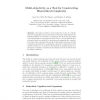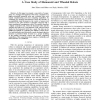10 search results - page 2 / 2 » Fault-tolerant locomotion of the hexapod robot |
GECCO
2003
Springer
14 years 18 days ago
2003
Springer
Abstract. This paper presents a novel perspective to the use of multiobjective optimization and in particular evolutionary multi-objective optimization (EMO) as a measure of comple...
ICRA
2007
IEEE
14 years 1 months ago
2007
IEEE
— This paper presents a method for the control of locomotion in a robot hexapod. The approach is based on the WalkNet structure, which in turn is based on the neural control stru...
IROS
2007
IEEE
14 years 1 months ago
2007
IEEE
Abstract— In this paper we present a case study of cooperation of a strongly heterogeneous robot team, composed of a highly articulated humanoid robot and a wheeled robot with la...
ICRA
2007
IEEE
14 years 1 months ago
2007
IEEE
— Legged robots are by nature strongly non-linear, high-dimensional systems whose full complexity permits neither tractable mathematical analysis nor comprehensive numerical stud...
ICRA
2000
IEEE
13 years 11 months ago
2000
IEEE
This paper describes the progress of the BIP2000 project. This project, in which four laboratories are involved for 4 years, as uimed at the realization of the lower part of an an...


